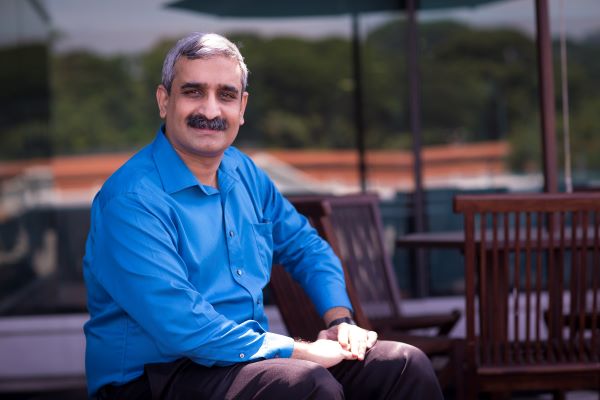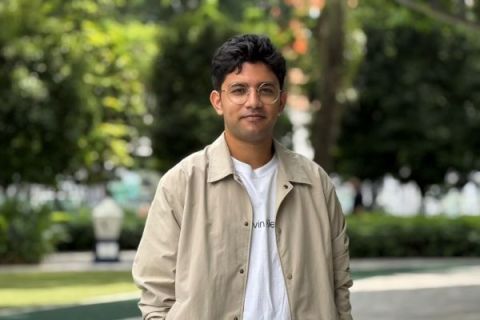
By Vince Chong
SMU Office of Research – With the surfeit of trackable, wearable devices in modern life, there is little problem locating things and people outdoors by leveraging Global Navigation Satellite System (GNSS) solutions (GPS is an example of this type of solution) that use signals from satellites. Indoors on the other hand, is a different matter as GNSS signals are unavailable and other possible signals such as those from Wi-Fi systems are inconsistent, and often distorted.
And when this ability to swiftly, accurately locate indoor objects is starkly crucial to essential services that make the difference between life and death, upgrading it becomes a key objective.
SMU Professor of Computer Science Rajesh Balan plans to do just that for the Singapore public agencies by harnessing a nascent Wi-Fi standard for which he is one of the world’s foremost experts.
“Indoor localisation remains an unsolved problem,” he tells the Office of Research.
“For public agencies, this is crucial. In many countries, particularly one like Singapore where 70 to 80 percent of people are indoors most of the time to beat the heat, the agencies need all the accuracy they can get to respond to any kind of call.”
His plan, centering on a Wi-Fi feature that uses time of flight measurements, known as round trip time measurements, or RTT, to get ranges between the Wi-Fi access point (AP) and the mobile device. This project is using a specialised variant, known as one-sided RTT, or 1-RTT, as this variant conveniently does not require changes to the AP. It was, in the second half of 2024, awarded a substantial grant under Singapore’s Translational Research and Development for Application to Smart Nation (TRANS) grant scheme, which calls on research institutes for translational technology-based solutions.
In a proposal submitted in February 2024, Professor Balan and his team set out to provide an “accurate, low-latency, minimal maintenance indoor localisation solution” for better general navigation and locational specificity. Latency, in IT speak, refers to the time taken between a user request and the completion of that request.
Seeing the “light”
Current low-latency – or speedy – indoor localisation solutions, that use existing Wi-Fi networks, determine where devices are via signal strength. This is measured in RSSI – received signal strength indication – by triangulating positions from multiple APs. Other possible solutions for indoor localisation include using bluetooth low energy, or BLE, which consumes very little power or hybrid systems but both but require using beacons or other devices that emit signals.
All of these, Professor Balan explains, require new hardware or identification of APs, and therefore breach preset project perimeters. His plan of using 1-RTT, on the other hand, purports to work with any Wi-Fi AP while fulfilling all project criteria.
The key difference between RSSI and RTT, he says, is that the former relies on signal strength that degrades with distance or presence of obstacles. RTT meanwhile acts like a light source with the X-ray capability to penetrate obstacles; it can continue to work as long as the Wi-Fi signal from an AP can be “heard” by a mobile device.
As such, RTT is a much more reliable method compared to those that use signal strength, he says.
The standard has in fact existed in many forms for decades, the academic continues, with one of its most reliable variants, two-sided RTT, only coming into play around 2021. However, like BLE beacons and cameras, it requires installation of hardware and so fails as an option.
Professor Balan has spent nearly three years exploring 1-RTT and he has also spent a year-long sabbatical at Google headquarters in Mountain View, California, US, where he worked in the Android indoor location team.
His sabbatical experience helped him understand the problem in much better detail as Google, as he tells the Office of Research, arguably possesses the largest, most viable – and proprietarily owned – global indoor localisation solution. This is evident from the tech company’s impressive reach in this area, as reflected in the use of Google Maps by competitors such as Apple and Samsung. However, as Professor Balan notes, state agencies require different solutions as they cannot share data with external companies like Google.
There may be other systems in the world that could possibly work, Professor Balan allows, but as far as he knows they apply only within certain countries such as South Korea or China.
Challenges but “confident that 1-RTT will work”
Developed as an alternative to two-sided RTT, 1-RTT has its challenges, as Professor Balan notes in his TRANS grant proposal. One of these lies in the way that the mobile device processes RTT measurements it makes to APs around it. Because the APs are unmodified, they do not assist the mobile devices in these measurements, and this causes delays in the measurement windows.
“These delays can be on the order of a few milliseconds and can lead to large errors in distance (as a few milliseconds multiplied by the speed of light results in a 1 to 3 km error!),” the proposal sets out. Fortunately, it continues to state, this error can be corrected.
The project kicked off officially on January 1, 2025, and at the time of writing lies in the hiring phase. It is expected to last two and a half years, though Professor Balan believes it may be more.
With the bulk of the work to come, how confident is he of success?
Projects under the TRANS grant scheme, Professor Balan answers, are funded for the purpose of delivery. In other words, the research involved is “translational by nature and cannot be too risky.”
“The most interesting part of the project will be how it integrates with the public agencies’ operational requirements,” he says.
“I am confident that this particular research will be delivered.”
Back to Research@SMU February 2025 Issue
See More News
Want to see more of SMU Research?
Sign up for Research@SMU e-newslettter to know more about our research and research-related events!
If you would like to remove yourself from all our mailing list, please visit https://eservices.smu.edu.sg/internet/DNC/Default.aspx

